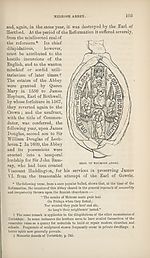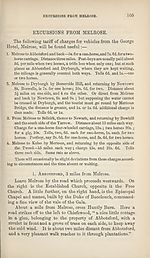Download files
Complete book:
Individual page:
Thumbnail gallery: Grid view | List view

104
MELROSE ABBEY.
Lord Haddington, who was afterwards created Earl of Hol-
derness, appears to have disposed of the possessions belong¬
ing to the lordship of Melrose, since we find that they were
granted by charter to Sir Thomas Hamilton (“ Tam o’ the
Cowgate”), a celebrated lawyer, who was created Earl of Mel¬
rose in 1619, and afterwards Earl of Haddington. Part of the
lands were conferred upon Walter Scott, Earl of Buccleuch; and
his descendants, about the beginning of the eighteenth century,
acquired by purchase the remainder of the Abbey lands in¬
cluded in the lordship of Melrose, which still form a part of
the extensive possessions of the same noble family.
At the abolition of heritable jurisdictions in 1747, the Lady
Isabella Scott was allowed the sum of £1200 sterling as com¬
pensation for her right to the bailiery of Melrose.
When King David I. laid the foundations of Melrose Abbey,
the ground on which Melrose now stands was occupied by a
village called Fordel. The present village is almost entirely
modern, and has little of the antique about it. In the centre
stands a cross, about twenty feet high, supposed to be coeval
with the Abbey. There is a ridge in a field near the town,
called the Corse-rig, which the proprietor of the field holds
upon the sole condition that he shall keep up the cross.
In the vicinity of Melrose are the Eildon Hills, the Tre-
montium of the Romans. The village of Gattonside, with its
numerous orchards, on the other side of the Tweed, is connected
with Melrose by a chain bridge. At Gattonside is Gattonside
House (General Duncan). Near it is the Pavilion (Lord Somer¬
ville), and Allerly (Sir David Brewster). A short way further down
the river, on a peninsula formed by a remarkable sweep of the
Tweed, stood the ancient monastery of Old Melrose. The estate
of Old Melrose was long possessed by a family of the name of
Ormestoun. It is now the property of Adam Fairholme, Esq.
of Chapel.
MELROSE ABBEY.
Lord Haddington, who was afterwards created Earl of Hol-
derness, appears to have disposed of the possessions belong¬
ing to the lordship of Melrose, since we find that they were
granted by charter to Sir Thomas Hamilton (“ Tam o’ the
Cowgate”), a celebrated lawyer, who was created Earl of Mel¬
rose in 1619, and afterwards Earl of Haddington. Part of the
lands were conferred upon Walter Scott, Earl of Buccleuch; and
his descendants, about the beginning of the eighteenth century,
acquired by purchase the remainder of the Abbey lands in¬
cluded in the lordship of Melrose, which still form a part of
the extensive possessions of the same noble family.
At the abolition of heritable jurisdictions in 1747, the Lady
Isabella Scott was allowed the sum of £1200 sterling as com¬
pensation for her right to the bailiery of Melrose.
When King David I. laid the foundations of Melrose Abbey,
the ground on which Melrose now stands was occupied by a
village called Fordel. The present village is almost entirely
modern, and has little of the antique about it. In the centre
stands a cross, about twenty feet high, supposed to be coeval
with the Abbey. There is a ridge in a field near the town,
called the Corse-rig, which the proprietor of the field holds
upon the sole condition that he shall keep up the cross.
In the vicinity of Melrose are the Eildon Hills, the Tre-
montium of the Romans. The village of Gattonside, with its
numerous orchards, on the other side of the Tweed, is connected
with Melrose by a chain bridge. At Gattonside is Gattonside
House (General Duncan). Near it is the Pavilion (Lord Somer¬
ville), and Allerly (Sir David Brewster). A short way further down
the river, on a peninsula formed by a remarkable sweep of the
Tweed, stood the ancient monastery of Old Melrose. The estate
of Old Melrose was long possessed by a family of the name of
Ormestoun. It is now the property of Adam Fairholme, Esq.
of Chapel.
Set display mode to:
![]() Universal Viewer |
Universal Viewer | ![]() Mirador |
Large image | Transcription
Mirador |
Large image | Transcription
| Antiquarian books of Scotland > Scotland/Scots > Black's picturesque tourist of Scotland > (164) |
|---|
| Permanent URL | https://digital.nls.uk/130030158 |
|---|
| Description | Thousands of printed books from the Antiquarian Books of Scotland collection which dates from 1641 to the 1980s. The collection consists of 14,800 books which were published in Scotland or have a Scottish connection, e.g. through the author, printer or owner. Subjects covered include sport, education, diseases, adventure, occupations, Jacobites, politics and religion. Among the 29 languages represented are English, Gaelic, Italian, French, Russian and Swedish. |
|---|

